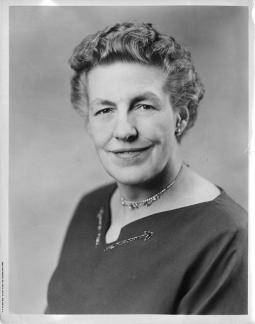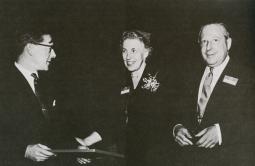Polio Place
A service of Post-Polio Health International
Mary Elizabeth Switzer
Born: February 16, 1900
Died: October 16, 1971
Major Contribution:
Mary Elizabeth Switzer was an American public administrator and social reformer. She worked within the federal bureaucracy from 1921 to 1970. Along with Gini Laurie, Mary Switzer has been called one of the grandmothers of the “independent living movement.”
She notably shaped the 1954 Vocational Rehabilitation Act, which provided a great expansion of vocational rehabilitation service for people with disabilities, as well as subsequent federal grants. Notably, she initiated grants to train rehabilitation counselors.
Switzer headed the Office of Vocational Rehabilitation (OVR) for 17 years, where she concentrated on bringing vocational training to all physically and developmentally disabled persons. The budget increased dramatically under her leadership. One of her arguments was that educated and trained people with disabilities would be employed and tax-paying citizens,
In addition, she used her authority to fund more than 100 university-based rehabilitation-related programs. Research on a wide range of disability conditions was beginning to be collected, studied and integrated into professional training policy and programs.
She supported cross-disability programs and, early on, supported intellectual disabilities (mental retardation) as being a part of the disability agenda and not just as part of education. She was active in the international disability arena and helped draft the constitution of the World Health Organization. She believed that support of international programs not only helped people with disabilities but that it was an example of democratic principles at work.
Other Information:
Brief Biography: Mary Elizabeth Switzer was born on February 16, 1900, to Julius F. and Margaret (Moore) Switzer of Newton Upper Falls, Massachusetts. She and her siblings were raised by relatives after her mother died when she was 5 years old, and because her father had deserted the family some years before that. Her Uncle "Mike" Moore was an Irish patriot and socialist. His ideas influenced Mary, and he encouraged her to work in a job that was useful.
After graduating from Radcliffe College (Radcliffe Institute for Advanced Study at Harvard since 1999) in 1921 with a B.A. in international law, she moved to Washington, D.C., to begin her first of many federal government positions. She was assistant secretary to the Minimum Wage Board and later worked for the Department of the Treasury until 1953, principally for the Public Health Service and the Federal Security Agency.
Her vision and foresight effectively shaped much of the core of the United States rehabilitation efforts from the 1950s through the 1970s. Along with Dr. Howard Rusk (considered the founder of rehabilitation medicine) and Henry Viscardi, Jr. (activist in employing the disabled), Mary forcefully advocated for the involvement of people with disabilities into the mainstream of American life.
In 1950, she was appointed Director of the Office of Vocational Rehabilitation (which, in 1961, became the Vocational Rehabilitation Administration), overseeing its move to the newly-created Department of Health, Education and Welfare (HEW) in 1953.
In 1967, responsibility for all federal rehabilitation services was combined under the Social and Rehabilitation Service (SRS) and Mary Switzer became its first administrator. Known as “the cutter of red tape,” she provided assistance to tens of thousands of people with disabilities; many of whom would later become activists themselves.
She joined others in spearheading such important innovations as the National Theatre of the Deaf and the Helen Keller Center for Deaf-Blind Youth and Adults. She retired in 1970 and became vice-president of the World Rehabilitation Fund, where she remained until her death in 1971.
Awards: Mary Switzer received the President's Certificate of Merit (1948) for her contribution to the war effort, the Albert Lasker Award in medicine (1960), the American Association of Workers for the Blind ‘s Ambrose M. Shotwell Memorial Award in 1962 for her outstanding contribution to the rehabilitation of blind persons.
She received honorary degrees from six universities and was the first woman to serve on the Board of Directors at Georgetown University in 1969. She served as president of the National Rehabilitation Association and as advisor to many American health organizations, including the Menninger Foundation.
Commemorations:
The Mary Switzer Building is a federal office building on C Street SW in Washington D.C., now housing the Social Security Administration and the United States Information Service.
The Mary E. Switzer Building, located on the Woodrow Wilson Rehabilitation Center campus in Fishersville, Virginia, features a display of Switzer's memorabilia.
Mary Switzer Research Fellowships are administered by the U.S. Department of Education Office of Special Education and Rehabilitative Services
Location and Description of Papers: Mary Switzer’s papers are part of the Schlesinger Library, Radcliffe Institute for Advanced Study and are available through the Harvard Library website. They contain correspondence, office files, reports and speeches.
Footnote citations:
1. History of International Rehabilitation
April 2013/Carol K. Elliott and Joan L. Headley/Post-Polio Health International




















































